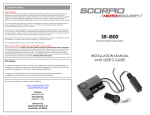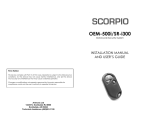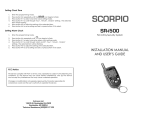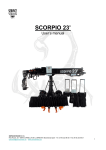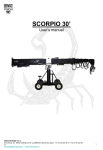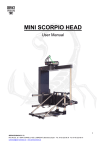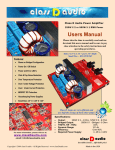Download SR-c400 Installation & User Manual
Transcript
SR-C400 Motorcycle Security System INSTALLATION MANUAL AND USER’S GUIDE Standard Features • • • • • • • • • • • • • • FM two way transceiver Up to ½ mile communication range Multi-color LED panel trigger indicator Waterproof remote transmitter Ultra low power drain MCM Built-in accelerometer Ignition protection Remote sensor control Battery safeguard with “sleep mode” Passive arming Selectable arming / disarming Integrated 125 dB multi-tone siren Remote panic feature Soft chirp arming Optional Accessories • • • • Perimeter sensor – A miniature multi stage microwave sensor that detects motion in mass around the motorcycle. Data Output – For future expansion. Back-up Battery - A built-in back-up battery feature allowing the siren and transmitter to continue operating when power is interrupted. Factory Connector Kits–OEM style connectors that simply plug into the motorcycle’s factory wiring harness. Connector kits are available for select motorcycle models. Table of Contents Installation • Component List ---------------------------------------------------------------• Planning The Installation ---------------------------------------------------• Mounting The Components ----------------------------------------------• Color Codes --------------------------------------------------------------------• Connections --------------------------------------------------------------------• Using the T-tap -----------------------------------------------------------------User’s Guide • Transceiver Charging Instructions ---------------------------------------• Receiver Status LED Panel --------------------------------------------------• Range LED -----------------------------------------------------------------------• Operating the transceiver -------------------------------------------------• Alarm Triggers-------------------------------------------------------------------• Adjusting G Sensor -----------------------------------------------------------• Selecting Arming Modes ---------------------------------------------------• Transceiver Battery -----------------------------------------------------------• Motorcycle Battery Safe Guard -----------------------------------------Optional Accessories Instructions • Perimeter Sensor (SN-5) -----------------------------------------------------• Back-up Battery ---------------------------------------------------------------• Data output ---------------------------------------------------------------------Warranty and FCC Information • Limited Warranty ------------------------------------------------------------• FCC Notice ---------------------------------------------------------------------• Contact information --------------------------------------------------------1 Page 3 Page 3 Page 4 Page 4 Page 5 Page 5 Page 6 Page 6 Page 6 Page 7 Page 8 Page 8 Page 9 Page 9 Page 9 Page 10 Page 11 Page 11 Page 12 Page 12 Page 12 Installation Components List MCM (Main Control Module) Remote Transceiver Generic Instillation Kit (GEN-1a) Main Harness (HAR-1a) Planning the Installation It is very important that before starting the installation of the security system, you carefully read the installation instructions and spend time planning the installation. By planning ahead you will be able to select the best approach in placing, securing and wiring the system to your specific motorcycle. Although the installation is not difficult, there are a number of steps that must be taken for the system to operate properly. We suggest the following steps: 1. 2. 3. 4. 5. 6. 7. Check that your motorcycle battery is fully charged and that all electrical circuits are in good working condition. Check the layout and construction of the motorcycle to decide what space is available to place the components. Verify that no moving parts interfere with the components or their wires. Do not route wires near sharp edges, which could cut wires and cause a short. Do not mount components near extreme heat areas such as exhaust pipes etc. Allow at least an inch or two of slack at all connection points to reduce the chance that a connection will break apart due to vibration. Select a suitable location underneath the seat or in a side cover. Mount the MCM using Velcro or cable ties. Make sure that it is not exposed or easily reached. 2 Mounting the Components Routing the Antenna Wire The MCM includes an 18” antenna wire. The first 12” is a coaxial wire; the remaining 6” is the reception antenna wire. When routing, try to avoid running the antenna along or near metal. For best performance, have the antenna wire as vertical as possible and exposed. Wire Connections The system includes one harness (HAR-1a) that connects directly into the MCM. The harness is split into three plugs: one for the GEN-1a connector, one for the optional SN-5 connector and one for the data output for future expansion. Note: Each plug is unique and will only fit the appropriate component one way. Main Harness Note: If the optional factory connector kit is being used, please disregard this section of the instructions and refer to the instructions supplied with the factory connector kit. The main harness consists of two harnesses. One is labeled (HAR-1a) and the second is labeled (GEN-1a). Plug in the white 4 pin connector from the (HAR-1a) into the matching 4 pin connector from the (GEN-1a). The (HAR-1a) also has a waterproof connector that plugs into the MCM. The wires should be connected as follows: HAR-1a Black wire with fuse and ring terminal – To battery Positive (+). GEN-1a Black wire – To ground (-). Orange wire – To tail light wire or any other wire that is hot (+) when ignition is ON (NOTE: this is an input to the alarm this connection is not designed to flash the tail light). Color Codes: Honda Kawasaki Suzuki Yamaha Harley Davidson Ground (-) Green wire Black wire Black/White Black wire Black wire 3 Tail Light Brown wire Red wire Brown wire Blue wire Blue wire Connections To Battery (+) Antenna HAR-1a *GEN-1a Plug SN-5 Plug DATA Plug MCM * If an Optional Factory connector is used then that would be used in place of the GEN-1a. Note: Connect the (HAR-1a) harness to the MCM only after installation is completed. If the battery is to be removed, disconnect this connector first. Reconnect only after battery terminals are reconnected. Note: When the main harness (HAR-1a) is plugged in, the siren should chirp. If the siren dose not chirp; check the fuse, and battery (+) and ground (-) connections. Using the T-tap Connectors 1) Place female T-tap connector over wire to be tapped, close and squeeze until it snaps. 2) Now slip male T-tap connector over hinged end of the female connector. Motorcycle Wire 1) Female T-tap 2) Female T-tap Male T-tap Motorcycle Wire Wire from (GEN-1a) 4 User’s Guide Transceiver (TRC-4) Range LED Receiver Status LED Panel Button #1 Button #2 Charger Input Button #3 Transceiver Charging Instructions The transceiver is pre-charged at the factory and will operate out of the box but we recommend that it be charge for at least 10 hours when first operated to insure full life of battery. 1. 2. 3. 4. Plug in provided charger into the transceiver. While the transceiver is charging the red status LED will flash twice every two seconds. When transceiver is fully charged no LED will flash. Recharge the transceiver every day to maintain full function. Receiver Status LED Panel The status LED panel provides information about the status of the receiver, memory and the battery level. Receiver On White LED will flash Receiver on / Low Battery Red LED will flash. Receiver on / Memory Trigger Blue LED will flash Range LED Range LED indicates when the transceiver is still with in receiving range of the system. Note: To conserve battery, the Range confirmation will only work for the first hour after activating the system. After the first hour the range LED will stop flashing and the transceiver will no longer indicate range status In Range Green LED will flash Out Of range Red LED will flash 5 Operating the transceiver The following instruction assumes that the transceiver is with in range of the motorcycle. Arming Press the #1 button, the siren will chirp 3 times. The transceiver will chirp twice and the white status LED will continuously flash to confirm that the receiver is on. The range LED light will then flash green. System is armed. Green Range LED will flash Button #1 White Status LED will flash Disarming Press the #2 button, the siren will chirp once. The transceiver will sound once followed by another long chirp. The red status LED will turn ON momentarily and the receiver will shut off. System is disarmed. Button #2 Red Status LED will flash momentarily Arming with the optional Perimeter Sensor Press the #3 button, the siren will chirp 4 times. Transceiver will chirp twice and the white status LED will continuously flash to confirm the transceiver is on. The range LED light will then flash green. System is armed with perimeter sensor Arming without siren (paging only) Press the #1 and #3 buttons at the same time, the siren will chirp 5 times. Transceiver will chirp twice and the white status LED will continuously flash to confirm the transceiver is on. The range LED light will then flash green. System is armed but the siren is disabled. Arming without optional perimeter sensor or siren / Paging Only Press the #2 and #3 buttons at the same time, siren chirps 4 times. Transceiver will chirp twice and the white status LED will continuously flash to confirm the transceiver is on. The range LED light will then flash green. System is armed but the Perimeter Sensor and siren are disabled. Panic/ Stop Trigger With the system armed press the #3 button for a panic feature. The siren will sound. Pressing the #3 button during an alarm trigger stops the alarm cycle but the system remains armed. 6 Alarm Triggers When the system is triggered, the siren will sound. The transceiver will flash all three panel LED’s for a few seconds, then a combination of panel LED’s will indicate the priority level: Short Alarm Short Alarm includes Shock and Perimeter sensor triggers. 1. If bike is bumped, or the perimeter sensor is activated the siren will sound for 5 seconds. • The white, red and blue status LED will flash in sequential order on the transceiver once every second. It would then be followed by three sequential chirps and vibrations on the transceiver. This cycle will repeat twice. Full Alarm Full Alarm includes Ignition and Tilt sensor triggers. 1. If the bike is tilted or the ignition switch is turned “on” the siren will sound for 30 seconds. • The white, red and blue status LED will flash at the same time on the transceiver once every second. It would then be followed by three sequential chirps and vibrations on the transceiver. This cycle will repeat six times. Note: Once an alarm trigger has occurred and the siren duration is completed, the system will remain armed and accept any additional triggers. The Blue status LED will flash indicating that a trigger has occurred. Adjusting G sensor Sensitivity Turn the ignition switch to the “on” position, press and hold down the #3 button, while holding down the #3 button turn the ignition switch off, release button #3. The siren will chirp to correspond with the current sensitivity setting. -Increase sensitivity- Press the #1 button -Decrease sensitivity- Press the #2 button 5 chirps = Level # 5 (Maximum) 1 chirp = Level #1 (Minimum To save the changes and exit sensitivity adjusting, press button #3. To exit with out saving changes, turn ignition “on” and back “off”. 7 Selecting Arming Modes The system offers two arming modes. Manual arming will require the user to activate the alarm when ever is needed. The Auto arming mode will activate the alarm automatically 60 seconds after the ignition is turned off. The system is preset to manual arming mode, to change to auto arming 1. 2. 3. Turn the ignition switch to the” on” position. Press and hold the #1 button until the siren chirps, then release. The current arming mode is indicated by the siren -Manual arming- siren chirps 2 times. -Automatic arming- siren chirps 3 times. 4. To change back to previous setting repeat #2 Transceiver Battery Information The receiver is automatically turned on when ever the system is armed. To conserve battery the transceiver should be turned off when not in use, or when it’s out of range for extended periods of time. Powering off receiver Press and hold the #2 button until the transceiver chirps and the red panel LED turns on and off. The receiver is turned off. Press and hold Button #2 Red Status LED will flash momentarily Low Battery Stages It’s recommended that the transceiver be charged daily when in regular used. If the transceiver is not charge daily the following stages will occur. Low Battery LED: The battery is low the red status LED will flash. The transceiver should be charged as soon as possible. Red Status LED will flash Receiver Turns Off: If the transceiver is not charged, at some point (approximately 7 days) the receiver will shut off. At this stage the receiver will keep shutting down every time the system is armed. No response: If the battery is not recharged and all power is drained. The transceiver will not respond. The transceiver has to be fully charged before it can operate the system again. Motorcycle Battery Safeguard with “sleep mode” • • • If the optional perimeter sensor is being used and the alarm is armed for more then 10 days the system will automatically disable the perimeter sensor. If the alarm is armed for more than 30 days, the system will automatically disable the systems receiver. In this mode the transceiver will no longer be able to operate the system but the system is still armed and protecting the bike. To disarm, trigger the alarm, and press the #1 button. 8 Optional Accessories Perimeter Sensor (SN-5) Mounting the SN-5 The Perimeter sensor uses high frequency microwave technology to detect mass density movement around the motorcycle. The signal can transmit through the seat, fiberglass, leather and plastic, but not metal. It is recommended to place this sensor under the seat as close as possible to the center of the motorcycle. With the provided Velcro, you can mount this sensor on top of the battery or any flat surface, making sure that the top side of the sensor is facing upwards. Adjusting the Sensor Although the sensor is pre set from the factory it may be necessary to adjust the sensitivity to suit your specific application. 1. Stand at least 10’ away from the motorcycle and arm the system. 2. Walk towards the motorcycle and try and lean over the top of it. Once the sensor detects movement the siren will begin to chirp slowly. If you back away from the motorcycle the siren will stop chirping. If you continue to move closer to the motorcycle the siren will start to chirp faster and faster and then go into a full alarm. 3. Sensitivity can be adjusted by removing the plastic cap and tuning the adjustment screw. To increase sensitivity, turn adjustment screw clockwise. To decrease sensitivity, turn the adjustment screw counter clockwise. 4. The Perimeter sensor has an internal tuning control, which has been set at the factory. This tuning control should only be changed if the sensor can not be properly set as described in #3 above, please call Aritronix’ technical support. Note: Do not turn sensitivity above half way. Doing so may cause false alarms. Plastic Cap : Remove to adjust sensitivity To Accessory Harness on Main Control Module (MCM) 9 Back-up Battery The back-up battery provides the system the ability to transmit information and activate the siren when power is interrupted. If power is ever interrupted while the system is activated the back-up battery will be engaged, the transceiver will receive a full alarm and the siren will sound in 25 second increments. If power is not restored the alarm will continue to transmit and sound for six cycles. Note: The system has to be correctly installed for at least 12 hours before full function of the back-up battery can be used. To check the status of the back-up battery active the system using button #1. • If the Alarm chirps 3 times the back-up battery is in good working condition • If the system chirps 2 times the back-up battery is not fully charge. Note: If the system chirps only 2 times and it has been correctly connected for more the 12 hours the battery needs replacement. (Contact Aritronix for replacement options) Data output A data output has been included with this system for future expansion. This section purposely left blank 10 Limited Warranty Scorpio-branded security products come with a 2-year (from time of purchase) limited warranty. This includes all components and accessories that are manufactured by Aritronix Ltd. The following sections describe the limited warranties. What is covered by this limited warranty? This limited warranty covers defects in materials and workmanship in your — our end-user customer's — Scorpio-branded hardware products, including Scorpio-branded accessory products. What is not covered by this limited warranty? This limited warranty does not cover cosmetic damage, damage/failure due to acts of God: Problems that result from: • • • • External causes such as accident, abuse, misuse, or problems with electrical power. Usage that is not in accordance with product instructions or modifications of the product. Failure to follow the product instructions. Problems caused by using accessories, parts, or components not manufactured or approved by Scorpio. What should you do if you experience a problem with a Scorpio product? First contact Aritronix, Ltd. using one of the methods listed below. [Proof of purchase, installer and motorcycle information will be requested]. If after assistance from our trained staff it is determined that the Scorpio product may be faulty then you will provide with detailed information on processing a warranty claim. All warranty claims must contain a return authorization number (RA#). Aritronix, Ltd. will not accept any package that does not have been approved for warranty repair/exchange. Shipping and Handling If a warranty claim is requested and approved a standard shipping and handling charge will apply. All charges have to be paid before package is returned back to customer. FCC Notice This device complies with Part 15 of FCC rules. Operation is subject to the following two conditions: (1) This device may not cause harmful interference, and (2) This device must accept any interference that may cause undesired operation. Changes or modifications not expressly approved by the party responsible for compliance could void the user’s authority to operate this device. For technical assistance with any of the procedures on this manual, or for warranty claims please contact Aritronix at: www.scorpioalarms.com [email protected] Toll Free (800)428-0440 International (480)951-1109 Aritronix Ltd 16055 N. Dial Blvd. B-10 Scottsdale, AZ 85260













